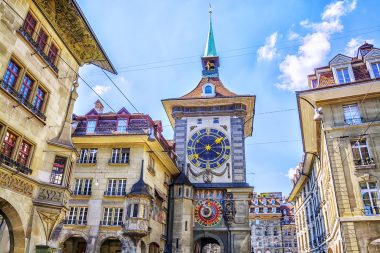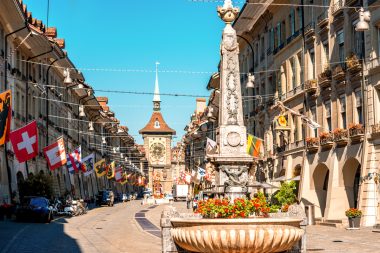For the first time, the name Bern was used on 1 December 1208. But already in the second half of the In the 2nd century BC, there was evidence of a fortified Celtic settlement on the Enge Peninsula, a bend in the Aare river. In Roman times, a Gallo-Roman vicus, a settlement with a small-town character, could be found on this site.
The foundation of today’s town took place towards the end of the 12th century by Duke Berchtold V of Zähringen. After the Zähringers died out, Bern became a free imperial city. Through the support of the Confederates in wars against noble houses and for protection against them, an alliance with Lucerne, Zurich and Waldstätten was formed. This alliance ended in the Swiss Confederation in 1353.
In the Swiss Confederation, there was a lot of resistance to a central capital. There should only be one federal city that houses the seat of the Federal Government, the Federal Assembly and the Federal Administration. The choice fell on Bern, which is now not a capital but a federal city.
Sights in Bern
The Old Town of Bern

Bern’s old town has been named a UNESCO World Heritage Site. It is still a testimony to medieval urban planning in Europe today. Here you will find many historic buildings worth seeing, such as the Clock Tower. The largely preserved sandstone facades and the unique roofscape of the houses also characterise the image of this part of Bern. The old town is located in the Aare loop. But it’s not just history that characterises this district of Bern, but also numerous bars and cultural institutions. And even the Aare offers a perfect setting for this peninsula with the Aare swim and the Aare rafting in summer.
Zytglogge (Clock Tower)

The Clock Tower is one of Bern’s most famous landmarks. Built as a defensive tower, the tower moved more and more into the center due to the expansion of the city. For example, it was used as a prison before the great fire of 1405. As a clock tower, it was rebuilt from Bernese sandstone. Inside the tower is a clockwork from 1530 that still does its job reliably.
At the Zytglogge there is a puppet show with dancing bears, the jester and Chronos, the god of time who turns an hourglass. But not only these figures inspire the audience, but also the astrolabe. The astronomical calendar clock shows the exact image of the stars with the Earth, with stars, moon and sun orbiting the blue planet. The current zodiac sign, the sunrise and sunset time and the date are also always displayed.
Gerechtigkeitsgasse and Kramgasse

The two alleys form the old main street. In the Middle Ages, both streets served as a market square. Many of the houses that were used as residential buildings still have elements of the late Gothic style. Most of the buildings were rebuilt in the 18th century and were designed in the Baroque style. But there are still houses in these alleys whose original shape has been preserved.
For example, house number 2 on Kramgasse has been home to the oldest pharmacy since 1527 and contains the earliest evidence of neo-Gothic. The most famous inhabitant of this alley was Albert Einstein. He lived with his wife Mileva in house number 49. Here in the Einstein House there is now a museum about the life and work of the physicist.
On Gerechtigkeitsgasse you will find the Golden Eagle in the house with number 2. It is Bern’s oldest tavern and hostel.
Both sides of the alleys were built with stone arcades on the houses. Under these arcades, you can stroll through the shops on the longest covered shopping promenade in Europe without getting your feet wet.
Fountains adorn the alleys of Bern
Fountain of Justice
The fountain from the 16th century stands on Gerechtigkeitsgasse. The octagonal building is adorned with the symbolic figure of justice, the statue of Justitia. Blindfolded, she lifts a sword with her right hand and carries a scale in her left. At the feet of the figure are a pope, an emperor, a sultan and a mayor.
Kreuzgassenbrunnen
The fountain was built in 1778 and has no figures. The fountain made of Solothurn limestone is considered the original form of the Bernese Obelisk Fountain.
Bern Cathedral
The Bern Cathedral is the most important and largest late medieval church in Switzerland. The church, built in the Gothic style, was not completed until the end of the 19th century. The foundation stone was laid in 1421, with the church being built clockwise around the already existing Leutkirche. Bernese sandstone was used for the building and the tower, but not the uppermost part. The last construction work was carried out with sandstone from Lower Saxony .
Many masterpieces of architecture can be discovered in the cathedral. The ornate church windows are decorated with stained glass. The choir vault of the church has 86 figurative keystones, which are still very well preserved. The main portal is particularly impressive. The figures created here from sandstone represent the Last Judgement.
The Bern Cathedral has various organs, with the large cathedral organ on the west gallery and the swallow’s nest organ on the south wall of the choir.
In the tower of the church there are 9 bells spread over 3 floors. The large bell from 1611 is the largest and heaviest bell in Switzerland and is decorated with Renaissance motifs.
Facts about Bern
- Bear Pit: The bear pit and the associated bear park are a well-known symbol of the city. According to legend, Bern was named after the first animal that the city’s founder, Duke Berthold V of Zähringen, killed while hunting – a bear.
- Center of Swiss politics: Although Zurich and Geneva are larger, Bern is the center of Swiss government. The Federal Convention and the Federal Council have their headquarters here.
- Bern Old Town: A UNESCO World Heritage Site, Bern’s Old Town is known for its well-preserved medieval architecture, arcades, and Zytglogge Tower, an impressive 13th-century astronomical clock.
- Paul Klee Centre: Bern is home to the Zentrum Paul Klee, which houses an extensive collection of the works of this famous painter.
- Education: The University of Bern, founded in 1834, is one of the most important educational and research institutions in Switzerland.
- Einstein and Bern: The famous physicist Albert Einstein lived and worked in Bern for a while. During his time here, he developed the special theory of relativity. His former home can be visited as a museum.
- Centre for Space Research: Bern has a long history in space research. The Institute of Physics at the University of Bern has developed instruments for a number of space missions, including the Apollo moon missions and the Mars Rover.
- Language: The official language in Bern is German, but most residents speak the local dialect, Bernese German.
- Sports: Bern has a vibrant sports culture, with football and ice hockey teams playing in the highest Swiss leagues. The city also hosted the 1954 FIFA World Cup.
- Rose Garden: A popular meeting place in Bern is the Rose Garden, from which you have a beautiful view of the old town. It was originally a cemetery and was converted into a public park in 1913.
Museums in Bern
- Zentrum Paul Klee: This museum is dedicated to the famous Swiss painter Paul Klee and houses the world’s largest collection of his works.
- Bern Historical Museum: It is the second largest historical museum in Switzerland and houses a wide collection of artifacts that shed light on the history of the city and canton of Bern, as well as other parts of the world.
- Kunstmuseum Bern: This museum is the oldest art museum in Switzerland with a permanent collection and houses works by artists such as Picasso, Paul Klee and Ferdinand Hodler.
- Einstein Museum: Within the Bern Historical Museum is the Einstein Museum, which is dedicated to the life and work of Albert Einstein, who lived and worked in Bern for a while.
- Swiss Alpine Museum: This museum offers a variety of exhibitions on the culture, nature and geography of the Alps.
- Bern Natural History Museum: This museum has an extensive collection of dinosaur fossils, minerals, animal and bird exhibits, and a special section dedicated to Albert Einstein.
- Communication Museum: It shows the history of communication, from the post office to the Internet, through interactive and multimedia exhibitions.
- Zytglogge: The Zytglogge, or Time Bell, is a medieval tower in Bern. It houses an astronomical clockwork and a museum that tells the story of the tower.
- Museum of Communication: This museum is the only one of its kind in Switzerland and offers interactive exhibitions on the history and development of communication.
- Swiss Shooting Museum: This museum is dedicated to the history of shooting sports and shooting festivals in Switzerland.




